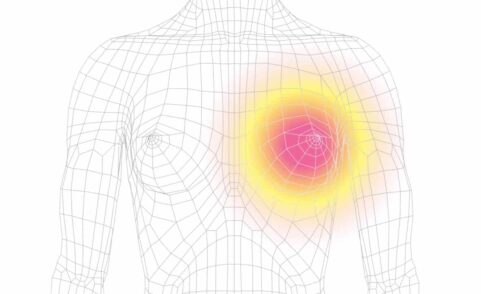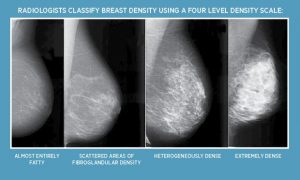
Managing Your Breast Cancer Risk
Posted In: Breast Imaging
Do you have dense breasts? Knowing the answer to this question is a key factor in early detection of breast cancer. The density of your breasts helps determine whether or not a mammogram will be enough to detect breast cancer or if you may need some form of supplementary screening.
To understand breast density, you need to know what’s in a breast. Your breast tissue is comprised of a collection of fat cells or adipose tissue that extends from your collarbone to under your arm and across the middle of your ribcage. In a healthy female breast, there will be around 12-20 sections called lobes which are connected by milk ducts (tubes) that carry milk to the nipple. This complex network is part of what is called the glandular tissue. It’s within this glandular tissue that most breast cancers develop.
When there is more glandular tissue (dense tissue) than fatty and supportive tissue (non-dense) tissue, your breast is considered dense. But it’s not something you can tell from a breast self-exam. Dr. Hayley Sheldon, a body and breast radiologist at RAYUS in Minneapolis explains, “The only way to know your breast density is with a mammogram.”
If you’re age 40 or older or have a family history of breast cancer, your first step is scheduling a mammogram to determine your density. Doctors will look at each breast individually because density can be different from the left to the right side. “When we look at a mammogram, we categorize each individual’s breast from A to D,” says Dr. Sheldon.
The most common method used to determine levels of density is the American College of Radiology’s Breast Imaging Reporting and Data System (BI-RADS). The categories are, (A) almost entirely fatty, (B) scattered fibroglandular density, (C) heterogeneously dense, and (D) extremely dense.

On a mammogram, fatty and connective tissue shows up as a grey color and glandular tissue shows up as white – as do cancerous tumors. The higher the breast tissue density – the harder it is to diagnose possible cancerous tumors. Looking for a small, early-stage cancer in a dense breast with a mammogram can be like trying to find a snowflake in a blizzard, says Carrie Riccobono, a Clinical Nurse Specialist with Froedtert RAYUS Breast Care in Milwaukee, WI.
Just because you have dense breasts doesn’t mean you’re at higher risk for developing cancer. But it can make that cancer harder to see.
“Breast density can decrease the sensitivity for mammography to detect early breast cancers. That is why we offer supplementary screening to patients with dense breast tissue. It is not required but it is suggested, especially if a patient has some family history and are at an intermediate risk of breast cancer.”
-Dr. Hayley Sheldon, RAYUS body & breast radiologist
Your radiologist will determine your level of density based on your mammogram. Then, along with an overall assessment of your risk factors, will discuss with you the need for supplementary screening.
Radiologists at RAYUS suggest that if you have dense breasts and fall into the “intermediate risk” category because of family history, you should consider 3D digital mammography (also called tomosynthesis). This imaging complements the standard 2D mammography and is performed at the same time. In fact, it only takes a few seconds longer to get 3D images.
If you have dense breasts and fall into the “high risk” category for breast cancer or have a family history of or have been diagnosed with breast cancer, your radiologist may recommend a breast MRI. This exam will provide highly detailed images of both breasts. For more information on what it’s like to get a breast MRI at RAYUS, click here to watch a video about the exam.
Knowing your breast density is just one piece of information you need to make the best choice for your breast cancer screening and aiding in early detection. But in 24 states, sharing this crucial information with the patient is not mandatory. Currently, 27 states have enacted mandatory breast density notification. Twelve states have no action, 10 states have introduced bills, and 2 states are currently working on bills. To find out more about the laws in your state, check out this interactive map.
Be your own advocate and ask your radiologist your BI-RADS level of breast tissue density, especially if you live in a state where sharing this information with the patient is not mandatory. At RAYUS, we do share this information with our patients because part of early detection of breast cancer is knowing the answer to the question: Are You Dense?